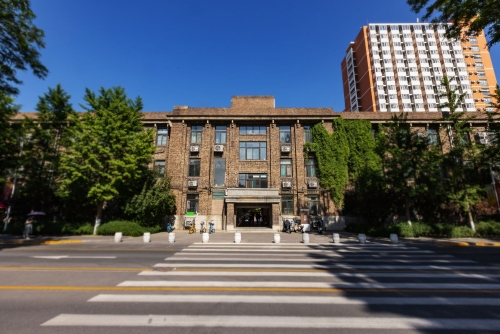
民主楼
Democracy Building

民主楼
Democracy Building



作品介绍
民主楼建于 20 世纪 50 年代初期,属于东校区最早的建筑之一。建设之初,为节约资金,民主楼所用材料均为“琉璃砖”,这种砖在烧制过程中因其表面凸凹不平,一般被作为次品,但其砖质结实、价格便宜,参与建设的师生结合砖质特点将这些琉璃砖利用得恰到好处:平整的一头砌墙用,带琉璃头的部分凸出在墙外,既不浪费,又美化墙体,给观者一种错落有致的美感,再加以琉璃砖统一的清灰色系,使民主楼彰显一种稳重庄严、简洁质朴的视觉风格。民主楼是当时北京高校中最长、也是当时设施最好的学生宿舍之一,每层配有两个卫生间、两个浴室,24 小时提供热水。民主楼因为 1957 年的民主整风运动而得名,承载了师生深切的历史记忆。值得提及的是,在小楼的历史里,包括李岚清在内的等多位党和国家领导人在这里居住生活。时光荏苒,不少老楼已无踪可寻,民主楼仍静立在农大校园,见证着学校的新发展。



Introduction to Works
The Democracy Building was built in the early 1950s and is one of the earliest buildings on the East Campus. At the beginning of construction, in order to save funds, the materials used in the democratic building were all "glass bricks". This type of brick was generally considered defective due to its uneven surface during the firing process. However, its brick quality was strong and cheap. Teachers and students who participated in the construction combined the characteristics of the brick quality to make good use of these glass bricks: A flat end is used for building walls, with a protruding part with a glazed head outside the wall, which is neither wasteful nor beautifying the wall, giving audiences a sense of staggered beauty. Combined with the uniform clear gray color of glazed bricks, the democratic building showcases a stable, solemn, and simple visual style. The Democracy Building was one of the longest and best equipped student dormitories among universities in Beijing at that time. Each floor was equipped with two bathrooms and two shower-rooms, providing hot water 24 hours a day. The Democracy Building is named after the 1957 Democratic Rectification Movement and carries the profound historical memories of teachers and students. It is worth mentioning that in the history of the Democracy Building, many party and state leaders, including Li Lanqing, lived here. Time flies, and many old buildings are nowhere to be found. The Democracy Building still stands quietly on the campus of Agricultural University, witnessing the new development of the school.




![<!--<$[信息标题]>begin-->民主楼<!--<$[信息标题]>end-->](/picture/0/s_86adc778b18f49a5a9f699558a691e28.jpg)
![<!--<$[信息标题]>begin-->民主楼<!--<$[信息标题]>end-->](/picture/0/s_e56ece8f56984a098afcfa23678adb27.jpg)
![<!--<$[信息标题]>begin-->民主楼<!--<$[信息标题]>end-->](/picture/0/s_c850ebe96e8243d3b74a6e305986f6ce.jpg)
![<!--<$[信息标题]>begin-->民主楼<!--<$[信息标题]>end-->](/picture/0/s_369fbec0950d4dafa5a4227bcf2c420d.jpg)


